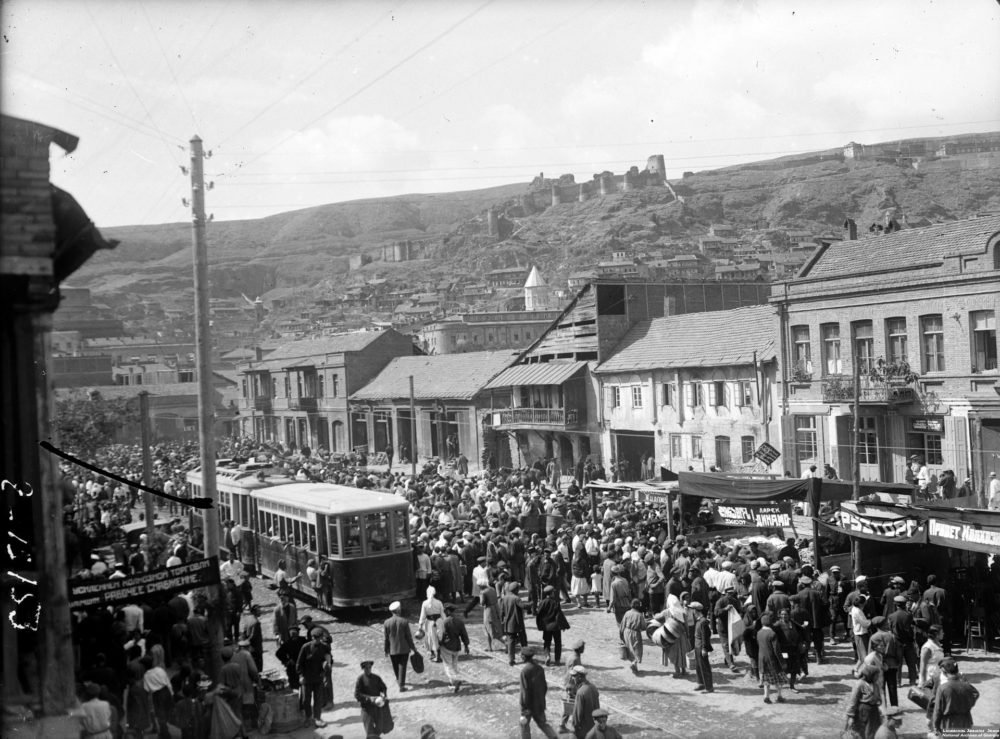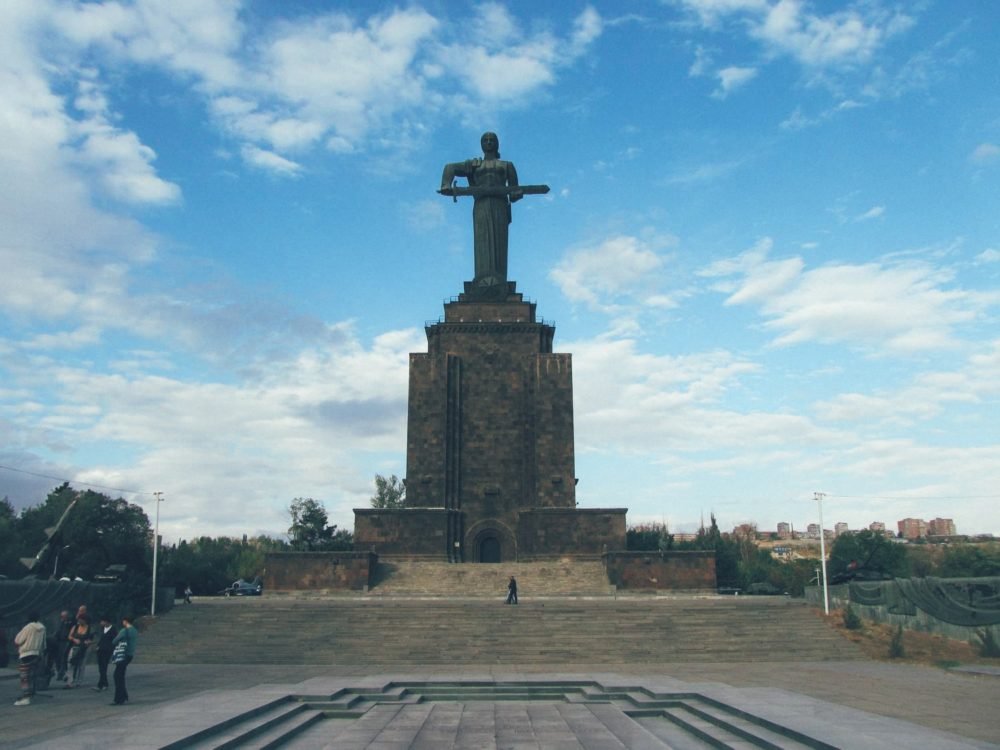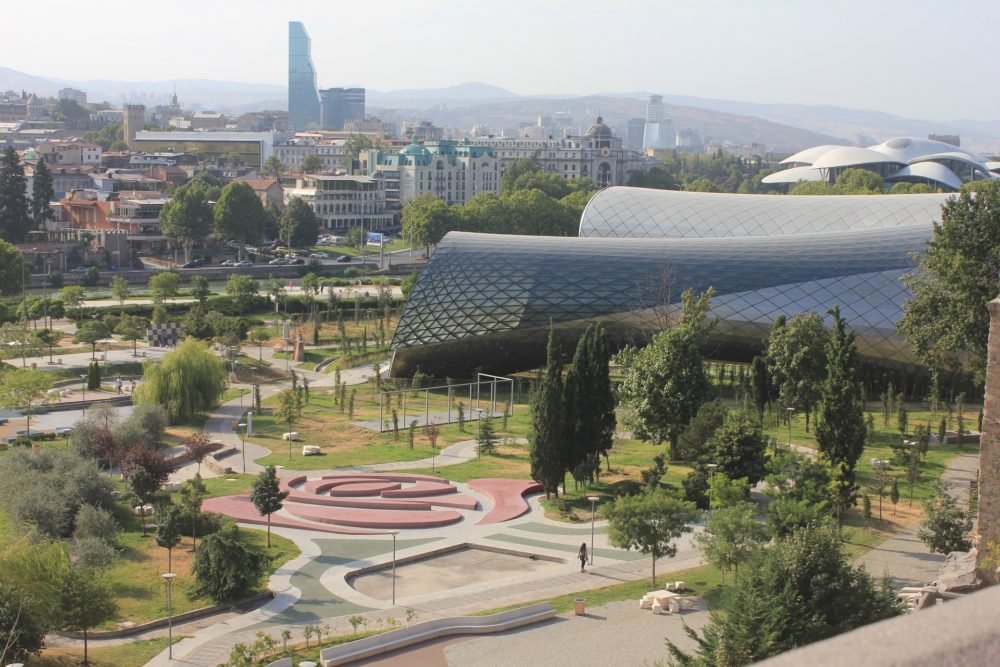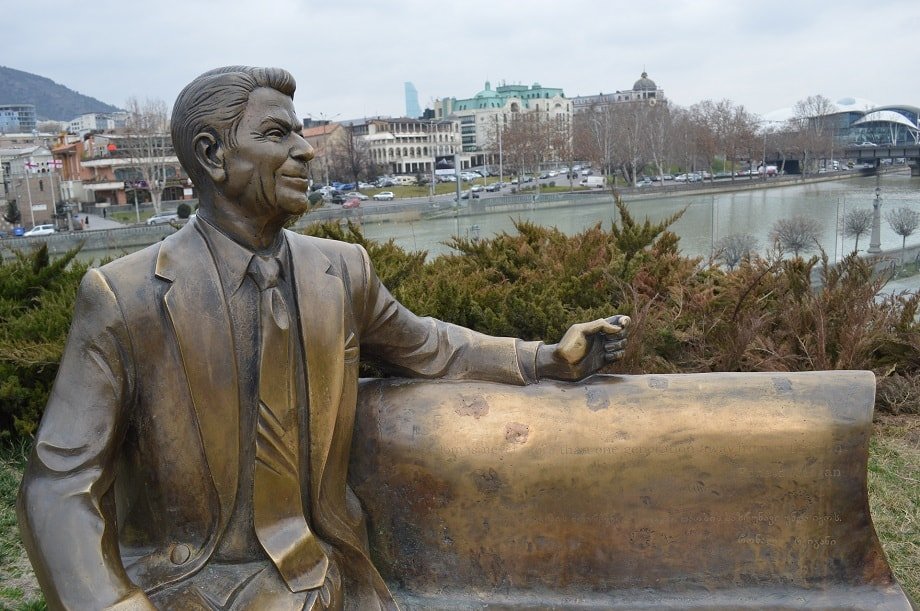
Contents
- Identity Construction and the Politics of Memory
- Georgia: History Revaluation
- Soviet Memorial Sights of Tbilisi
- Memorial Sites of Modern Tbilisi
- Dealing – Away – With the Past
- Footnotes
Identity Construction and the Politics of Memory
The collapse of the Soviet Union brought to the creation of 15 independent states that faced the necessity to construct their new identity – both internally and externally. The latter would pave the way to joining the “international community”. “To some extent, identities create opportunities and constraints for foreign policy-making, and also frame relations between countries.”[1]
The identity construction of a new state is a complex process requiring special instruments. Modern political communities use a collectively shared notion of the past as one of the main tools. Appealing to the past is a convenient instrument and resource for the legitimization of the existing political order. How the shared past is conceptualized and processed constitutes the politics of memory within a society.
In its turn, the politics of memory uses various instruments for the construction of a shared notion of the past. The official historical narrative is the principal of such instruments and is complemented, disseminated, and popularized by others. Among them, nation-wide holidays and commemoration days, school programs, national symbols, the creation of memorial sites and museums are the most efficient tools for the instrumentalization of the past and the construction of the state’s official narrative of history.
Undoubtedly, in this process those who carry out and experience the politics of memory have to deal with the heritage of the previous periods as well. “The history of most post-Soviet countries is characterized by the rise and triumph of nationalism and a radical revision of approaches to the history writing that dominated in the previous periods.”[2] Across the post-Soviet space, these revisions brought an overhaul of not only the official historical narratives but also the entire memory landscapes of the societies. This analysis looks into the post-Soviet transformations of the memory landscape in Tbilisi by re-visiting its memorial sites and monuments.
Georgia: History Revaluation
The area of today's Rike Park in the Soviet period. Electronic copy of the photograph obtained from the National Archives of Georgia.
Georgia was one of the first countries that gained independence from the Soviet Union. Ever since, the state is seeking to form its identity. Like virtually every former Soviet Union country, Georgia started a revaluation of history as part of this quest. The political elites had to provide a memory project aimed at establishing a new foundation narrative, or a new “story” of beginnings, bringing back the “lost” historical memory[3]. The revaluation of history manifested also in commemoration policies and the memory landscape. Before delving into the examination of memorial sites and monuments in Tbilisi, let’s look at a few milestone events catalyzing this revaluation of history.
From Shevardnadze to Saakashvili
In Georgia, due to the chaotic political processes of the 1990s and the beginning of the 2000s, a new state politics of memory was not systematic or targeted. The ethno-political conflicts in Abkhazia and South Ossetia followed by their independence claims as well as the economic and political crises in the country drew all efforts towards policies aimed at stability. Consequently, in the decade following the collapse of the Soviet Union, neither attention nor resources were directed towards conceptualizing and implementing a new politics of memory.
The shaky times of the first decade of independence unfolded under the rule of one of the most prominent Soviet politicians Eduard Shevardnadze, who used to be the Minister of Foreign Affairs of the Soviet Union. This period ended with the so-called Rose Revolution highlighted by massive protests against the results of the 2003 parliamentary election, skewed in favor of political parties supporting Shevardnadze. The name of the Rose Revolution derives from the culminating moment of the protests, when demonstrators led by Mikheil Saakashvili stormed the Parliament session with red roses in hands. Shevardnadze resigned in November 2003, and Mikheil Saakashvili won the presidential elections.
The Rose Revolution
The Rose Revolution and the developments that followed marked a new direction for the independent Georgian state. The Saakashvili government made an unambiguous choice to prioritize integration with Western institutions and adoption of its system of values. As Saakashvili took the presidential office, the politics of memory emerged as the key instrument for constructing a new, modern, and pro-Western Georgia.
History was the first target of revision. The events of the eras of the Russian Empire and the Soviet Union were reassessed, reinterpreted, and revised. Even though since 2003 Georgia has changed 3 presidents and even switched from the presidential system to the parliamentary system, the politics of memory of the country remains sufficiently consistent. Perhaps the August 2008 war was the next milestone cementing this politics.
The August 2008 War
The August 2008 war played a crucial role in the formation of the new Georgian identity and became a catalyzer for the revision of history. The August 2008 events were perhaps the junction point where not only the relations between Russia and Georgia split into periods of “before” and “after”, but the entire Georgian politics of memory and identity.
It is true that starting from the early 1990s, Georgia’s major foreign policy objective has been balancing Russian power and influence, which is seen as key to enhancing the country’s national security. Yet this foreign policy was the result of the quest, driven by political elites, for a new national identity rather than pragmatic considerations[4]. Thus, the 5-day war of 2008 was a “logical” extension of the Georgian identity-driven foreign policy struggling to be within Western and Euro-Atlantic spheres of influence, contrary to Russia’s aspirations to keep Georgia in its own zone of influence. In a self-fulfilling prophecy, the events of August 2008 reinforced this identity-driven foreign policy. The Georgian politics of identity and memory turned into a radical rejection of the country’s Soviet past and of any Russian influence at large.
One of the consequences of the war was the adoption in May 2011 of the Charter of Freedom with three main tenets: strengthening national security, prohibiting Soviet and Fascist ideologies and eliminating any symbols associated with them, and eventually creating a special commission to maintain a black-list of persons suspected of collusion with foreign special forces.
These events both influenced the emergence of a new politics of memory and were influenced by it. Moreover, their reverberations spread across the physical appearance of Tbilisi. As we view the transformations of the post-Soviet memory landscape, manifested in the memorial sites and monuments of Tbilisi, we have considered both those created in the Soviet period and those constructed in the independence period.
Soviet Memorial Sights of Tbilisi
The 70 years of Soviet rule had a huge impact on the political, economic, and cultural domains of life in all Soviet Republics as well as the countries of the communist bloc. Bolsheviks, coming to power after the fall of the Russian Empire and the emergence of another empire – the Soviet Union, started creating a new cultural heritage that would reflect the communist view on political and social structures, their meanings and functions. The memory landscape and urban environment of the Soviet Union were the direct projections of the prevailing political system and its values. And of course, Tbilisi was not an exception.
As everywhere else in the communist world, in Tbilisi too there sprung up monuments bearing the mark of the Soviet political and social system. However, after the collapse of the Soviet Union, the meaning of those monuments and even their very construction was revised.
“[…] it is not a surprise that during times of political turbulence and change, some of the monuments gain an extra meaning and significance and become objects symbolizing or externalizing societal dynamics and changes.”[5]
The extra meaning and significance of monuments in times of political turbulence can mean both the construction and celebration of new ones as well as the destruction and demise of old ones. The early 1990’s was a period of Georgia’s release from the Soviet past and many monuments embodying the Soviet culture were dismantled from Tbilisi. The Rose Revolution and the August 2008 war brought a new wave of revolutionary changes to the urban environment of Tbilisi.
And yet, despite all the effort of the new Georgian political system to erase the legacy of the Soviet past, rather than to deal with the past, there is still political, social, and cultural memory that persists. And of course, there are still monuments of Tbilisi that date back to the Soviet times. In the new political system, these monuments gain new interpretations, meanings, and significance for the Georgian society.
We have examined two monuments erected during the Soviet times, preserved until now, and – in our opinion – significant for their social and political value. We have looked at how they have been reframed within the modern political system of Georgia and the construction of the new Georgian identity.
The Mother of Georgia Monument on the Sololaki Hill
The monument Mother of Georgia or Kartlis Deda was designed by sculptor Elguja Amashukeli and erected on the top of the Sololaki hill in 1958, the year Tbilisi celebrated its 1500th anniversary. The 20-meter-tall aluminum statue, wearing a Georgian national dress and holding a cup of wine in one hand and a sword in the other, is said to symbolize the Georgian national character; wine stands for hospitality and the sword represents every Georgian’s strive for freedom.
The notion of a “mother of the nation” and embodiment of this notion into a monument of a woman is not unique to Georgia; many states of the former Soviet Union have the very same statue. Moreover, these statues are all in the style of socialist realism hovering over Kiev, Volgograd, Yerevan, and other cities of the post-Soviet space.
The "Mother Armenia" monument in Yerevan, Armenia. Photo Credits: Tatev Bidzhoyan.
"The Motherland Calls" monument in Volgograd, Russia. Photo Credits: Yuliya Drachenko, taken from https://goo.gl/jMVczY.
"The Motherland" monument in Kiev, Ukraine. Photo Credits: Maria Karapetyan.
Nevertheless, the modern Georgian society by and large does not perceive Kartlis Deda as a cultural remnant of the Soviet Union but rather as a collective image of the Georgian people. Not manifesting a specific individual, Kartlis Deda was easily integrated into the new national discourse and is supposed to be a figure that every Georgian could identify themselves with. Mother Georgia is “the most important woman in all Georgia: its protector and a standing definition to others of what Georgia is”[6].
Memorial of Glory in Vake Park
Another colossal monument erected during the very last years of the Soviet Rule, more specifically in 1985, is the Memorial of Glory, dedicated to the 300,000 citizens of Georgia that lost their lives during the years of the Great Patriotic War of 1941-1945 and the victorious triumph of May 9 over Nazi Germany.
The then Minister of Foreign Affairs of the Soviet Union Eduard Shevardnadze conceived the idea of the monument, aiming to prove his loyalty to the central Soviet government. This was an effective move since “Victory Day has become the quintessential ritual of a Soviet culture and society in which Russia – or rather, the Russian-speaking world – was presented as its epicenter”[7].
Former Georgian President Mikheil Saakashvili, pursuing de-Sovietization policies, made efforts to change the meaning of the monument and the significance of the victory day itself. For example, in 2005, he celebrated the victory in World War II, and no longer in reference to the Great Patriotic War, with the US President George Bush in Liberty Square, and not in Vake Park. A further attempt to downplay the Soviet meaning of the monument was the multiple depiction of the modern Georgian flag on the lower part of the monument.
In 2011, in another move aimed at re-focusing attention between historical events, Saakashvili’s government initiated a project that would mount a new memorial in Vake Park, dedicated to the 1924 anti-Soviet riots. The site was to commemorate Kote Abkhazi, a well-known leader of the liberal nobility of Georgia, and his division that the Communist regime shot in Vake Park in 1923[8]. The installation of the monument was planned for February 2012. However, the monument was not erected. The Georgian government that came after the defeat of Mikheil Saakashvili’s political party returned the celebration of the victory in World War II to Vake Park. Nevertheless, in both official and public discourses, the celebration is said to commemorate the victory in World War II, and not in the Great Patriotic War.
Memorial Sites of Modern Tbilisi
The cityscape of Tbilisi from Rike Park. Photo Credits: Katie Sartania.
Modern Tbilisi is a dynamic city with a multi-layer architecture. It is an eclectic mix of the medieval, the imperial, the Soviet, and the modern. The most remarkable monuments of the memory landscape in the capital of independent Georgia were constructed after the 2003 Rose Revolution. The then president Mikheil Saakashvili and his government paid a special attention to the politics of memory and symbols.
We have examined three monuments crowning the city-scape of Tbilisi and that – in our opinion – best illustrate the new politics of memory of independent Georgia.
The Statue of Saint George on Freedom Square
The statue of Saint George tops the column in the middle of Freedom Square in Tbilisi. The square itself, or rather its name, deserves a small excursion into its own layers of transformation. Its name unveils the turns in Georgian history. When Georgia was part of the Russian Empire, the square bore the name of Knyaz Ivan Paskevich-Erivanskiy and was called Erivanskiy Square. This name lasted until the Sovietization of Georgia. In the Soviet era, it was initially named after Lavrentiy Beria and later on renamed after Vladimir Lenin, with his statue erected in the square in 1956. Following Georgia’s independence, the place was renamed Freedom Square. This was the name of the square at the time of the first Georgian republic that existed in 1981-1921, between the fall of the Russian Empire and Sovietization. Despite this change that bridges the old and the new, even today, some of the older residents of Tbilisi call the place Lenin’s Square.
In the place of the dismantled statue of Lenin’s, a new one dedicated to Saint George was mounted on November 23 in 2006. Designed by the well-known Georgian sculptor Zurab Tsereteli, the monument embodies Saint George killing a dragon.
In the new political mythology of Georgia, Saint George is not only the patron saint of Georgia and its protector, it is the symbol of Georgia’s fight for freedom and independence. In this new interpretation, the defeated dragon on the monument symbolizes the imperial legacy – both Russian and the Soviet. Hence the monument not only echoes the distant mythological past but also the recent past. Moreover, as literary scholar Zaal Andronikashvili argues, it promises a future victory as well. The mythological past is projected onto the modern political context and foreshadows the future[9].
Heroes Memorial
One more remarkable example of Mikheil Saakashvili’s sophisticated politics of symbols was the opening of the Heroes Memorial on the Heroes Square in 2009 right after the August 2008 war. The 51-meter memorial is dedicated to Georgians who died in the fight against the Red Army in 1921, the anti-Soviet revolt of 1924, the war in Abkhazia in 1992-1993, and the August 2008 war in South Ossetia. Around 4,000 names of soldiers are engraved on the marble tiles of the memorial.
The Heroes Memorial not only fuses together the past events by the mechanism of analogy but also alludes to the future. As former president Saakashvili noted, the memorial is not only for the heroes who have already died for their country but for the heroes who will sacrifice their lives for the country in the future as well. In his speech at the opening ceremony, he made a clear point: “If we want Georgia to exist, we should all be ready to put on this uniform [referring to the military uniform he was wearing]; we should all be ready to take arms in the decisive moment; and we should all be ready to fall on our land and ready to inscribe our names on the empty parts of this monument. That is the genetic code and historic experience of our country and a major guarantee of our future”[10].
Earlier, in 2003, near the same square, another memorial to Georgians fallen in the wars of Abkhazia and South Ossetia was put up again following the initiative of Mikheil Saakashvili who was then the head of the Tbilisi City Council[11].
The opening of both memorials gave two specific messages made by the government of Georgia to its society and the international community. The first message is that Georgia’s independence, sovereignty, and territorial integrity are absolute values. And the second message was about the government’s perception of who is perceived as a threat to those absolute values. The Russian support for the breakaway regions of Abkhazia and South Ossetia in the 1990s, as well as the August 2008 war followed by the recognition of their independence, contributed most to the formation of the perception of Russia as the number one foe of Georgia.
The Statue of Ronald Reagan in Rike Park
The statue of Ronald Reagan in Rike Park. Photo Credits: Anna Sarkisyan.
New memorial sites and monuments appeared in Tbilisi not only to mark the distancing from the Soviet past but also to mark new alliances. The relatively new statue of the 40th US President Ronald Reagan is an example of that element of the new politics of memory and symbols in Georgia. Unveiled in November 2011 near the Mtkvari River in Rike Park, the statute depicts Ronald Reagan, sitting on a bench with crossed legs, smiling, and looking off into the distance towards north, perhaps in the direction of Russia? Inscribed on the bench is one of Reagan’s remarkable phrases: “Freedom is never more than one generation away from extinction”.
Following the pattern, Mikheil Saakashvili presented the statue as a symbol of freedom and victory over the biggest evil – the Soviet Union. During his speech on the opening ceremony of the statue he said in reference to the then Russian Prime Minister Vladimir Putin’s words: “the leader of our invader state has announced that the collapse of the Soviet Union – the Soviet Union that was brought down by Ronald Reagan – was the 20th century’s biggest geopolitical catastrophe. […] While they [Russia] have restored the anthem of the Soviet Union, we are unveiling a statue of Ronald Reagan as a sign of the difference between our ideology and theirs”[12]. Referring to the creation of the Eurasian Economic Union between Russia, Belarus, and Kazakhstan, Mikheil Saakashvili once again associated the Soviet Union with Russia only and made an attempt to distance Georgia from its undesirable past.
Dealing – Away – With the Past
A changing politics of memory is always indicative of a changing political course and is called to justify that course. In this analysis, we looked at a number of memorial sites in Tbilisi both from the soviet and post-Soviet periods, analyzing them from the perspective of the modern Georgian political system, the quest for and construction of a new Georgian identity, and the politics of memory and symbols.
The revaluation of Georgia’s past in the Imperial Russian and Soviet realms, the celebration of freedom and independence, and Georgia’s turn towards a pro-Western path of development are at the core of this politics. Some old monuments that have no hope of surviving in the new system of coordinates are demolished. Others are revised and reinterpreted into the new paradigm. Yet new ones are mounted and unveiled.
Footnotes
[1] Kakachia, Kornely. 2013. “European, Asian, or Eurasian?: Georgian Identity and the struggle for Euro-Atlantic Integration.” In Georgian Foreign Policy: The Quest for Sustainable Security, 41-53.
[2] Kirchanov, Maksim. 2017. “Politics of Memory as Historical Politics in Georgia: From Desovietisation to the Invention of the Sovietness.” Georgia Monitor. Accessed January 6, 2018. http://www.georgiamonitor.org/upload/kyrchanoff_vsu_mgimo_2017_engl.pdf.
[3] Toria, Malkhaz. 2014. “The Soviet Occupation of Georgia in 1921 and the Russian-Georgian War of August 2008. Historical Analogy as a Memory Project.” In The Making of Modern Georgia, 1918-2012: The First Georgian Republic and Its Successors, edited by Stephen F. Jones, 316-335. New York: Routledge. Accessed January 6, 2018. https://goo.gl/dHLJw3.
[4] Kakachia, Kornely. 2012. “Georgia’s Identity-Driven Foreign Policy and the Struggle for Its European Destiny.” Caucasus Analytical Digest 4-7. Accessed January 6, 2018. http://www.css.ethz.ch/content/dam/ethz/special-interest/gess/cis/center-for-securities-studies/pdfs/CAD-37-4-7.pdf.
[5] Javakhishvili, Jana. 2016. “Stones Speaking: Reading Conflicting Discourses in the Urban Environment.” Caucasus Analytical Digest 8-11. Accessed January 6, 2018. http://www.laender-analysen.de/cad/pdf/CaucasusAnalyticalDigest80.pdf.
[6] Constable, David. 2012. “Kartlis Deda: The Importance of Georgia’s Most Famous Woman.” Huffington Post. October 29. Accessed January 6, 2018. http://www.huffingtonpost.co.uk/david-j-constable/kartlis-deda-the-importan_b_1776626.html.
[7] Edwards, Maxim. 2016. “Victory Day in Tbilisi.” Open Democracy. May 10. Accessed January 6, 2018. https://www.opendemocracy.net/od-russia/maxim-edwards/victory-day-in-tbilisi.
[8] 2011. “In Vake Park the Memorial to be Installed in Commemoration of 1924 Riot.” GHN News Agency. August 28. Accessed January 7, 2018. http://eng.ghn.ge/news-4309.html.
[9] Andronikashvili, Zaal. 2011. “The Glory of Feebleness. The Martyrological Paradigm in Georgian Political Theology.” In Identity Studies, Volume 3, 92-119. Tbilisi: Ilia State University. Accessed January 7, 2018. http://ojs.iliauni.edu.ge/index.php/identitystudies/article/view/27.
[10] 2010. “Saakashvili Addresses Nation on Independence Day.” Civil.Ge. May 26. Accessed January 7, 2018. http://www.civil.ge/eng/article.php?id=22340.
[11] 2004. “В Тбилиси у мемориала воинам, погибшим в боях в Абхазии и Южной Осетии, установлен почетный караул.” Ria Novosti. February 26. Accessed January 7, 2018. https://ria.ru/society/20040226/535327.html.
[12] 2011. “Ronald Reagan Statue Unveiled in Tbilisi.” Civil.Ge. November 23. Accessed January 7, 2018. http://civil.ge/eng/article.php?id=24178%E2%80%8F.
* This story has been produced with support from the US Embassies in the South Caucasus. The opinions expressed in the publication reflect the point of the view of the authors. They do not purport to reflect the opinions or views of the US Embassies.
** All photos of this story were taken by Katie Sartania and Tatev Bidzhoyan unless credited otherwise.
*** This story is part of a series on post-Soviet transformations of the memory landscapes, memorial sites, and monuments in Tbilisi, Yerevan, and Baku.






Archived comments
Thanks a lot for the article post.Much thanks again. Fantastic.